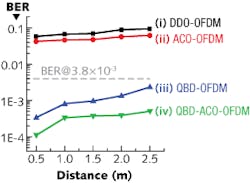FREE-SPACE COMMUNICATIONS: Short-range white-light LED datacom reaches 2.1 Gbit/s
Visible-light communication (VLC) systems that enable one- or two-way communication between white-light LEDs and computers or mobile devices are drawing the interest of researchers, as the technique could replace wireless Wi-Fi communications and offer increased data rates. To increase bandwidth, VLC developers often use orthogonal frequency-division multiplexing (OFDM), which divides the transmitter’s modulation spectrum into frequency bands. However, OFDM has the problem of second-order nonlinearity distortion that appears when direct detection is used.
Researchers at Fudan University (Shanghai, China) have developed a VLC system based on quasi-balanced detection (QBD) in which opposite signals are applied to odd and even consecutive symbols, allowing a single detector to be used while eliminating second-order signal distortions.1 In addition, the researchers use a red-green-blue (RGB) white LED rather than a blue-emitter/yellow-phosphor LED, which allows them to independently modulate the three colors to create a simple form of wavelength-division multiplexing (WDM).
The QBD-OFDM operation itself happens mostly in the electrical portion of the system. Applying QBD in the OFDM coding allows the measurements of receiver photocurrent as a function of time to be analyzed in a way that enables the removal of second-order intermodulation distortion and DC offset. An additional benefit is a 3 dB improvement in the receiver sensitivity.
For the WDM portion of the setup, a commercial RGB LED with wavelengths of 620, 520, and 470 nm producing a luminous flux of about 6 lm was used. Avalanche photodiodes with a gain of 1 and a sensitivity of 0.42 A/W and covered with R, G, and B filters served as receivers. An arbitrary-waveform generator was used to create the test signals.
The LED output was made low enough so that the LED was not operating in or near saturation. A lens with a 100 mm focal length captured the LED light and delivered it to each detector; the data was recorded by a commercial high-speed digital oscilloscope with a 500 megasample/s recording rate.
Because a real-world VLC link would typically have a distance between transmitter and receiver of 3 m or less, the researchers varied the transmission distance between 0.5 and 2.5 m in 0.5 m steps. The data rate of 2.1 Gbit/s was the result of a WDM combination of red at 750 Mbit/s, green at 650 Mbit/s, and blue at 700 Mbit/s.
Bit-error-rate (BER) measurements were taken for two modulation techniques: QBD-OFDM, and direct-detection optical OFDM (DDO-OFDM). At a 0.5 m distance, the BERs for the so-called sub1 and sub2 signals for the red, green, and blue LEDs were improved by 25.6, 31, 30.3, 25.8, 21.8, and 19.3 dB, respectively.
Using just the green LED for simplicity, the researchers then compared four modulation techniques: QBD-OFDM, DDO-OFDM, asymmetrically clipped optical OFDM (ACO-OFDM), and QBDACO-OFDM. Only the QBD-OFDM and QBD-ACO-DFM were able to provide BERs of less than 3.8 × 10-3, which, in their setup, is the maximum level at which bit-error correction functions to provide error-free transmission. They provided this performance over the entire experimental range from 0.5 to 2.5 m (see figure). The researchers say the QBD approach is a good one for low-cost VLC networks.
REFERENCE
1. Y. Wang et al., Opt. Exp., 21, 23, 27558 (November 18, 2013).
About the Author
John Wallace
Senior Technical Editor (1998-2022)
John Wallace was with Laser Focus World for nearly 25 years, retiring in late June 2022. He obtained a bachelor's degree in mechanical engineering and physics at Rutgers University and a master's in optical engineering at the University of Rochester. Before becoming an editor, John worked as an engineer at RCA, Exxon, Eastman Kodak, and GCA Corporation.

